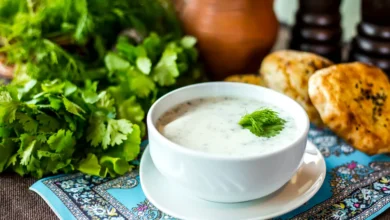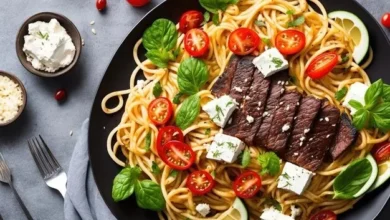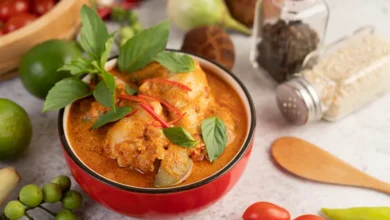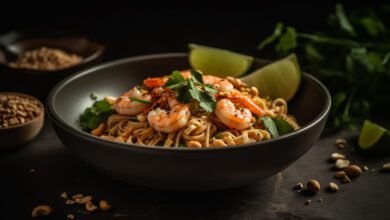Easy Chimichurri Sauce Recipe: The Classic Argentine Marinade
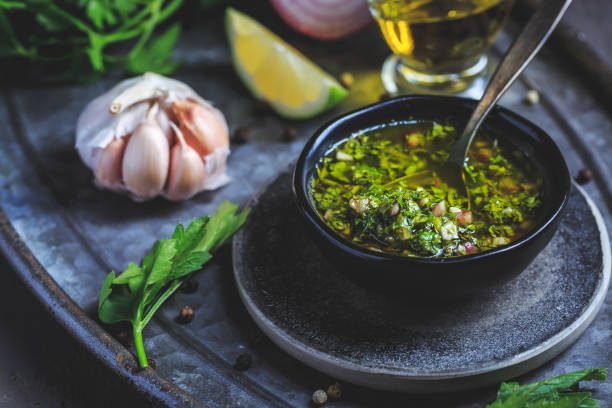
There is nothing quite like discovering a new culinary delight, and for me, that discovery was chimichurri sauce. On a family trip to Argentina several years ago, I was captivated from the very first bold, vibrant flavors of the herb-forward sauce when it was used to complement the grilled meats at a local asador. The combination was nothing short of heavenly. I knew immediately that I had to find a way to recreate this sauce at home, so I could enjoy those flavors whenever my taste buds desired. Upon returning, I set out to develop my own quick, easy and authentic chimichurri recipe using simple ingredients that are made and sourced without difficulty. It had become a staple condiment in our house. After fielding many requests from readers on my Instagram stories, I decided to share this recipe, so others can discover the magic of chimichurri for themselves.
Contents
- What is Chimichurri?
- Easy Chimichurri Sauce Recipe
- Ingredients
- Directions
- How Long Does Chimichurri Last?
- Uses For Chimichurri Sauce
- Frequently Asked Questions (FAQs)
- What is chimichurri sauce made of?
- Can I use regular parsley for chimichurri?
- Why does my chimichurri taste bitter?
- What is a substitute for red wine vinegar in chimichurri sauce?
- What is chimichurri sauce used for?
- How long does chimichurri last?
- Can you freeze chimichurri?
- Why is my chimichurri bitter?
- What is the difference between pesto and chimichurri?
What is Chimichurri?
Chimichurri hails originally from northern Uruguay and southern Argentina, where it has been used for centuries as both a marinade and a tangy, herbaceous dipping sauce to accompany grilled and roasted meats of all kinds. At its essence, chimichurri is a sauce made from a blend of olive oil, red wine vinegar, minced garlic, red pepper flakes, and finely chopped fresh parsley. Some recipes also call for the addition of dried oregano.
Depending on its place of origin within South America, chimichurri can take on various hues and flavor profiles. The most traditional version has a vibrant green color derived from an abundance of fresh herbs. However, there is also a red variation that derives its color from roasted red bell peppers, while still incorporating many of the similar ingredients as the green version. For this recipe, I have opted to share instructions for recreating the classic green version first made popular in Argentina.
What Does Chimichurri Taste Like?
Chimichurri has a bright, fresh, and intensely herby flavor that comes from the abundance of coarsely chopped herbs it contains. The sauce tastes predominantly of parsley, but there are also notes of oregano and other herbs. Acidity is provided through the use of red wine vinegar, which gives it a nice tangy edge. A potent dose of minced garlic lends robust garlicky flavors. A few dashes of red chili peppers or crushed red pepper flakes inject a nice spicy touch as well.
With its chunky and somewhat loose texture from the coarsely chopped herbs, chimichurri can best be described as a thick yet pourable chunky sauce somewhere between a traditional green salsa and a lush chunky herb oil. It adds incredible flavor when used to accompany simply grilled or roasted meats, fish or vegetables. The brightness of the herbs really sing through in each delicious bite.
A Carmen Foodie’s Tip: When choosing parsley for chimichurri, it’s best to select the youngest, freshest sprigs you can find. More mature and darker parsley becomes noticeably more bitter as it ages. Look for young, bright green leaves without any yellowing or browning. Older parsley can sometimes impart unwanted bitter flavors to chimichurri, thanks to natural compounds that become more concentrated as the herb seasons. Starting with top-quality, mildly flavored parsley will help ensure your chimichurri has the perfect balance of herbaceousness without bitterness.
What You Need to Make This Simple, Vibrant Chimichurri Sauce?
- Olive Oil: A high quality extra virgin olive oil forms the base of this sauce, and is the perfect dose of healthy fats.
- White Wine or Champagne Vinegar: I recommend using either white wine or champagne vinegar to add the all-important acidity to this recipe.
- Garlic: I recommend using 3-4 fresh garlic cloves that are mashed or finely minced. Not only does garlic add delicious flavor, but it is an essential part of what makes chimichurri, chimichurri.
- Sea Salt: A pinch of salt is needed to season the sauce, especially since this recipe uses no other ingredients containing sodium.
- Seasonings: For extra depth of flavor, I like to season my chimichurri sauce with a combination of crushed red pepper flakes, oregano and smoked paprika. Yum!
- Cilantro & Italian Parsley: Both cilantro and Italian parsley are essential for making that true chimichurri taste and its vibrant green color and herbaceous flavor.
Easy Chimichurri Sauce Recipe
Course: SaucesCuisine: Argentinian12
servings5
minutes190
kcal5
minutesThis classic Argentinian chimichurri sauce recipe makes a fresh, herbaceous condiment that beautifully complements grilled meats, seafood, rice dishes and more. With just a handful of pantry staples, you can quickly whip up this bright green sauce that brings big flavor in every bite.
Ingredients
1/2 Cup Extra Virgin Olive Oil
2 Tablespoons White Wine or Champagne Vinegar
2 Cloves Garlic mashed
1 Teaspoon Sea Salt
1/2 Teaspoon Crushed Red Pepper Flakes
1 Teaspoon Oregano
1 Teaspoon Smoked Paprika
3/4 Cup Italian Parsley, finely chopped
1 1/2 cups fresh cilantro (stems and leaves)
Directions
- Prep the ingredients – Be sure to wash and dry all herbs. The stems of cilantro actually contribute a lot of flavor too, so feel free to use them.
- Chop the parsley and cilantro and place in a small bowl. In a separate larger bowl, whisk together the olive oil, vinegar, mashed garlic cloves, sea salt, red pepper flakes, oregano and smoked paprika.
- To finish, you can either whisk the herbs into the oil-vinegar mixture or place everything into a food processor, blender or stick blender to blend until no large pieces remain, and it has a uniform consistency. Adjust any seasonings to your preferred taste if necessary.
- Serve with your favorite grilled meats, fish or steak. Any leftovers can be stored in an airtight container like a mason jar and kept in the fridge for up to one week.
How Long Does Chimichurri Last?
For freezing the homemade chimichurri sauce for longer storage, simply pour portions of it into an ice cube tray and freeze. Once frozen solid, pop out the cubes and transfer to a freezer container or bag. The sauce will last 3 months this way in the freezer. You can also freeze larger amounts of chimichurri directly in an airtight freezer container or bag.
When you’re ready to use your frozen chimichurri cubes, simply thaw them at room temperature or in the fridge overnight. You can also thaw chimichurri that was frozen in a container by leaving it in the refrigerator overnight. Be sure not to heat in microwave. The homemade sauce will also keep fresh for around 7 days stored in an airtight container in the regular refrigerator.
Uses For Chimichurri Sauce
In Argentina, where chimichurri originated, it is commonly used both as a marinade and sauce to accompany grilled meats like steak, fish, chicken, lamb and more. Beyond that, it also makes a delicious topping for tacos like Grilled Baja Shrimp Tacos, Buffalo Chicken Tacos or pasta – anything where its bright herb flavors would match or complement the other ingredients. Feel free to drizzle it on top of your favorite dishes for extra herby-garlicky-tangy heaven.
Let me know in the comments how else you enjoy using your homemade chimichurri sauce! I’d love to hear about any creative or traditional ways you might use it in your favorite dish.
Using Chimichurri as a Sauce
The vibrant flavors of chimichurri bring so much life to any dish it tops. When used as a sauce, it is particularly excellent with grilled or roasted proteins. Some favorites of mine include flank steak and hanger steak. The acid in chimichurri really balances and cuts through the heaviness and richness of beef. It also stands up gorgeously to simply prepared chicken or fish.
Beyond meats, this versatile herb sauce is delicious drizzled over rice, potatoes, or baked vegetables too. The endless possibilities are really what make chimichurri such a staple in my cooking. It adds brightness wherever there may be something in need of a light touch. So don’t be afraid to get creative – chimichurri was made for enhancing heavy or savory dishes.
Using Chimichurri as a Marinade
Chimichurri also works great as a marinade. The herbs and acid in it gently break down proteins while infusing intense flavor. I love to marinate steak or chicken in chimichurri overnight before cooking. Simply take whatever protein you want to marinade and coat it generously in chimichurri, sealing it in a bag or dish. Let it marinade for at least several hours, or overnight is even better.
When ready to cook the marinaded protein, be sure to cook it in a pan with a bit of the leftover chimichurri to cook as well. This helps the reserved sauce caramelize and infuse even more flavor into the meat. Grilling or pan searing marinaded meats also results in a gorgeous, nice color thanks to the acids and herbs in chimichurri.
RELATED: Zesty Homemade Remoulade Sauce
RELATED: Creamy Garlic Alabama White Sauce
Wrapping It Up
With its bright flavors of garlic, herbs and tangy vinegar, chimichurri is a versatile condiment that elevates many dishes. This recipe captures the authentic Argentinian flavors in a fresh and healthy sauce. A homemade batch will keep you eating chimichurri for days to come. Keep some on hand to take grilled meats and meals to new flavor heights.
————————————
Frequently Asked Questions (FAQs)
What is chimichurri sauce made of?
Chimichurri sauce is traditionally made with fresh herbs like parsley, oregano, and cilantro. It also contains garlic, red wine or apple cider vinegar, olive oil, salt, and red pepper flakes. The vinegar provides acidity, olive oil acts as the base, and the herbs and seasonings give it bright flavor.
Can I use regular parsley for chimichurri?
Yes, you can use regular parsley for chimichurri. Italian flat leaf parsley is typically preferred, as it has a stronger flavor than curly parsley. But regular curly parsley will still work in a pinch.
Why does my chimichurri taste bitter?
Chimichurri can taste bitter if the parsley used is older or more mature. Darker, older parsley contains more bitterness. Try using the youngest, freshest sprigs possible. Overly reducing the vinegar can also cause bitterness.
What is a substitute for red wine vinegar in chimichurri sauce?
Good substitutions for red wine vinegar in chimichurri include apple cider vinegar, white wine vinegar, or lemon juice. Any acidic ingredient will work to balance the flavors.
What is chimichurri sauce used for?
Chimichurri sauce is commonly served with grilled or roasted meats like steak, chicken, lamb and fish. It’s also used as a marinade or spread. The bright flavors complement barbecues and complement savory dishes.
How long does chimichurri last?
Refrigerated chimichurri will last about a week. It can also be frozen in ice cube trays or containers for 3–6 months. Thaw overnight in the fridge before using.
Can you freeze chimichurri?
Yes, chimichurri freezes very well. Freeze it in ice cube trays and store in bags or containers for up to 6 months. Thaw in the fridge overnight before using. This extends its shelf life for long term storage.
Why is my chimichurri bitter?
In addition to reasons above, over-chopping herbs can release bitter juices. Make sure to gently chop them by hand. Over-reduction of vinegar or using bitter varieties of parsley are also common causes of bitterness.
What is the difference between pesto and chimichurri?
Pesto uses basil as the primary herb and includes pine nuts, Parmesan and olive oil. Chimichurri is made primarily of parsley, with vinegar instead of nuts/cheese. Pesto is a thicker paste, while chimichurri has a thinner, pourable texture like a sauce. They both add intense herb flavor but in different styles.

